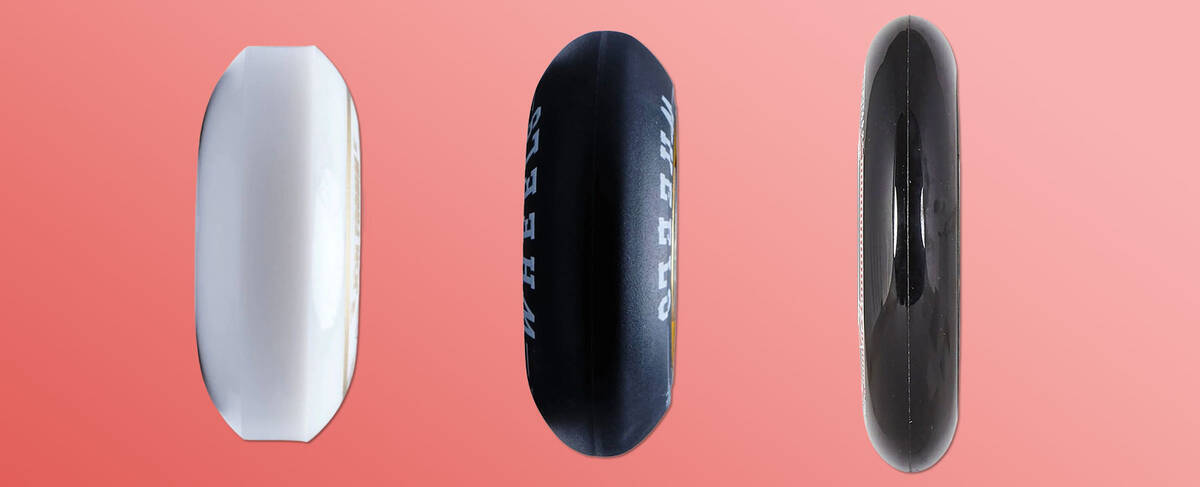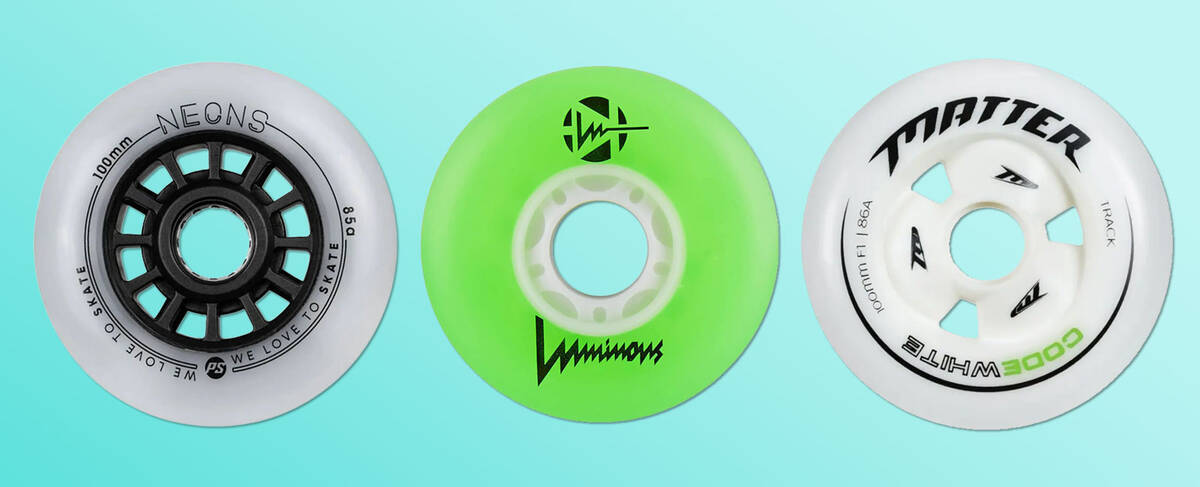Inline Skate Wheels: The Complete Guide

- Wheel size: Influences both speed and manoeuvrability.
- Durometer: Wheel hardness – impacts speed and vibration absorption.
- Rebound: Indicates how swiftly the wheel returns to its original form after compression.
- Grip: Shows how effectively the wheel grips the ground.
- Wheel profile: Modifies speed and stability.
Overview
Overview
Which Inline Skate Wheels Are Best for You?

Selecting the correct inline skate wheels becomes simpler if you understand which wheels are suitable for your specific skating style.
Regardeless of your inline skating style, it is crucial to consider the size and hardness of the wheels carefully and align them with the surfaces you will be skating on.
| Inline Skating Style | Attributes | Size Range / Hardness Range |
| Fitness Skate Wheels |
Smooth roll Power transfer
|
80-110 mm 80A-88A |
| Freeskate Wheels |
Agile and fast |
75-110 mm 84A-88A |
| Aggressive Skate Wheels |
Stable and shock-absorbing Compact size Flat or round profiles |
55-80 mm 88A-95A |
| Roller Hockey Wheels |
Agile and grippy Efficient acceleration Some designed for indoor use |
65-84 mm 72-84A
|
| Speed Skate Wheels |
Maximum speed Indoor / rinks / outdoor / roads |
100 mm-125 mm 83A-90A |
Inline Skate Wheels: Compatibility Matters

Inline skate wheels are typically 24 mm wide, allowing seamless compatibility with your skates. Any wheel that doesn't exceed your rollerblade frames' maximum wheel diameter can be adapted.
By comprehending aspects like hardness, rebound, grip, and profile, you can select wheels that not only fit your skates but also optimise their performance.
Continue reading for detailed insights, or explore our selection:
Inline Skate Wheel Size and Diameter

The diameter of an inline skate wheel is measured in millimetres (mm) and is typically marked on the wheel's side. If uncertain, you can measure the diameter yourself.
Wheel diameter plays a crucial role in determining inline skate wheel behaviour. Attributes such as acceleration, speed, manoeuvrability, and directional stability are influenced by the wheel size.
The influence of wheel diameter on performance:
- Smaller diameter: Offers better acceleration and control.
- Larger diameter: Results in higher top speeds and improved directional stability.
Each skating style requires a specific wheel diameter. Below, we outline our general recommendations for various inline skating styles:
Size Guide for Inline Skate Wheels
| Inline Skating Style | Size Range |
| Aggressive Skate Wheels | 55-80 mm |
| Roller Hockey Wheels | 65-84 mm |
| Fitness Skate Wheels | 80-110 mm |
| Freeskate Wheels | 75-110 mm |
| Speed Skate Wheels | 100-125 mm |
Hardness Levels of Inline Skate Wheels

The hardness of rollerblade wheels is commonly measured using the durometer scale, a standard method for gauging materials like rubber and plastics. The A-scale is frequently employed for rollerblade wheel durometer, indicated by a number followed by an A (e.g., 82A), with higher numbers representing harder wheels.
The A-scale facilitates quick identification of relative wheel hardness, typically displayed on the wheel's side.
The ideal wheel hardness varies based on your skating style. Below are our general recommendations for choosing appropriate inline skate wheel hardness:
Hardness Guide for Inline Skate Wheels
| Inline Skating Style | Hardness Range |
| Aggressive Skate Wheels | 88A-95A |
| Roller Hockey Wheels | 72A-84A |
| Fitness Skate Wheels | 80A-88A |
| Freeskate Wheels | 84A-88A |
| Speed Skate Wheels | 83A-90A |
Wheel hardness affects how well the wheel performs on various surfaces and conditions. Always consider wheel hardness, as it significantly influences your skates' functionality.
Comparing Hard and Soft Inline Skate Wheels
The impact of wheel hardness on performance is crucial, especially when choosing between wheels of differing hardness.
Here's how wheel hardness affects rollerblade performance:
Advantages of harder wheels- Increased speeds
- Longer durability
- Reduced grip
- Lower vibration absorption
- Greater grip
- Enhanced shock absorption
- Decreased speed
- Shorter lifespan
In general, softer wheels offer better vibration absorption and superior grip, while harder wheels reduce vibration absorption and grip.
Alternative Hardness SCALES
Certain brands employ the footprint scale for evaluating rollerblade wheel hardness. Here's the conversion of the footprint scale to the A-scale:
- F0 - approximately 88A
- F1 - approximately 85A
- F2 - approximately 84A
- F3 - approximately 83A
Understanding Rebound in Inline Skate Wheels
Rebound refers to a wheel's capability to swiftly revert to its original shape post-compression. With every stride, the wheel compresses. A high rebound allows the wheel to return to its shape quickly, aiding in speed, whereas low rebound absorbs energy without contributing to speed. Consequently, wheel rebound significantly affects speed.
High rebound is typically a feature of premium-quality wheels. Many manufacturers designate high rebound wheels as SHR urethane, representing Super High Rebound. Although there is no universal method for comparing wheel rebound, generally, more cost-effective wheels have lower rebound, whereas pricier ones from reputable brands tend to offer higher rebound.
Enhancing Grip with Your Inline Skate Wheels
The grip of inline skate wheels is determined by the properties of the polyurethane (PU) formula used in the wheel's rubber. Notably, wheel hardness plays a pivotal role.
Relation between wheel hardness and grip:
- Softer wheels: Provide better grip.
- Harder wheels: Offer less grip.
Surface conditions dictate how well a wheel grips. On especially slippery surfaces like rinks or indoor skateparks, additional grip is required to prevent sliding. In contrast, on rougher surfaces, such as asphalt, wheel grip isn't as problematic.
Therefore, skating on such rough surfaces allows for relatively harder wheels without compromising on traction.
Exploring Wheel Profile in Inline Skating

Inline skate wheels vary from flat to pointy profiles, determining the contact width between the wheel and surface. Flat profiles provide larger contact patches, while pointy ones offer smaller patches.
Pointy wheels are popular across many skating styles, including fitness and speed skating. Their narrow contact patch lessens friction, leading to increased efficiency. On the market, pointy wheel profiles are dominant due to their versatility and speed attributes.
Flat wheels cater to aggressive skating. Although slower, they provide stability advantageous for executing tricks.
Rounded wheels are common in freeskating and aggressive skating. In aggressive skating, rounded wheels, often part of flat setups, lower wheel bite risks. Their ease of control suits beginners who benefit from their forgiving nature.
Delving into Hubs for Inline Skate Wheels

The core of an inline skate wheel, known as the hub, holds the bearings in place. Hubs typically comprise hard plastic or aluminium. Usually, aluminium cores, depending on the design, are heavier but offer superior impact resistance and durability compared to plastic cores.
Inline skate wheel hubs can be categorised into these main types:
- Solid core: Highly robust but heavier.
- Spoked core: Lighter but less durable than solid core wheels.
- Hollow core: Balances low weight and durability.
For peak performance, inline skate wheels should be strong, durable, yet lightweight. Lighter wheels demand less energy to lift the skates, enhancing efficiency and lowering fatigue.
Maintaining Inline Skate Wheels
We suggest efforts to prolong your wheel lifespan. Typically, wheels wear down quicker than other skate parts, so strategic planning can yield cost savings. Adopting a regular wheel rotation schedule can increase their lifespan and maintain peak skate performance.
A natural wear pattern of inline skate wheels shifts the centreline outward, creating a diagonal flat surface on the wheel's inward side. Such wear is detrimental to your technique and signals the need for wheel rotation.
```By regularly rotating rollerblade wheels, you can maintain their even shape. If you're unsure of the correct method, we suggest consulting our detailed guide on wheel rotation:
If you are uncertain about whether to replace your inline skate wheels, our informative guide offers clarity on the matter:
For assistance with mounting wheels, follow this handy guide:
For general upkeep advice for inline skates, check out our comprehensive online resource packed with practical tips here:
... And What About Bearings?
For insights into wheel bearings, we offer specialised guides. This detailed guide provides all the information you require about their functionality:
If your roll feels less smooth lately, it could be due to worn-out bearings. Consider giving them a deep clean and fresh lubrication to restore functionality:


